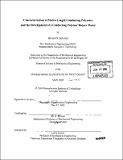| dc.contributor.advisor | Ian W. Hunter. | en_US |
| dc.contributor.author | Schmid, Bryan D. (Bryan David), 1981- | en_US |
| dc.contributor.other | Massachusetts Institute of Technology. Dept. of Mechanical Engineering. | en_US |
| dc.date.accessioned | 2006-03-29T18:36:08Z | |
| dc.date.available | 2006-03-29T18:36:08Z | |
| dc.date.copyright | 2005 | en_US |
| dc.date.issued | 2005 | en_US |
| dc.identifier.uri | http://hdl.handle.net/1721.1/32345 | |
| dc.description | Thesis (S.M.)--Massachusetts Institute of Technology, Dept. of Mechanical Engineering, 2005. | en_US |
| dc.description | Includes bibliographical references. | en_US |
| dc.description.abstract | Conducting polymers are a subset of materials within the electroactive polymer class that exhibit active mechanical deformations. These deformations induce stresses and strains that allow for conducting polymers to be used as an actuator for mechanical devices. Incorporation of conducting polymer actuators into mechanical devices requires electrochemical and mechanical characterization of varying polymer sample sizes and their active properties. Of particular interest, is the characterization of macro-length polymer samples, which have yet to be investigated. An understanding of conducting polymer films and their feasibility as an actuator in a mechanical device are required for the development of a conducting polymer based rotary motor. The conducting polymer, polypyrrole, was studied for its feasibility as an actuator for control surfaces on autonomous underwater vehicles. Enhancements to the actuator's performance were addressed following the feasibility study. The development of an electrochemical dynamic mechanical analyzer provides an instrument for characterization of the polymer's properties over a variety of sample sizes and actuation conditions. Finally, the application of polypyrrole as an actuator and possible enhancements combined with the characterization of macro-length polymers provides the necessary tools to develop a rotary motor. Enhancements to polypyrrole actuators in this study account for an increase in tip force of 350% and a seven fold increase in achievable strain. | en_US |
| dc.description.abstract | (cont.) Completion of a novel electrochemical dynamic mechanical analyzer, construction of a finite rotary motor able to subtend angular displacements, and the developed embodiment of a polymer based rotary eccentric motor are accomplished in this study. | en_US |
| dc.description.statementofresponsibility | by Bryan D. Schmid. | en_US |
| dc.format.extent | 145 leaves | en_US |
| dc.format.extent | 7386032 bytes | |
| dc.format.extent | 7393791 bytes | |
| dc.format.mimetype | application/pdf | |
| dc.format.mimetype | application/pdf | |
| dc.language.iso | eng | en_US |
| dc.publisher | Massachusetts Institute of Technology | en_US |
| dc.rights | M.I.T. theses are protected by copyright. They may be viewed from this source for any purpose, but reproduction or distribution in any format is prohibited without written permission. See provided URL for inquiries about permission. | en_US |
| dc.rights.uri | http://dspace.mit.edu/handle/1721.1/7582 | |
| dc.subject | Mechanical Engineering. | en_US |
| dc.title | Characterization of macro-length conducting polymers and the development of a conducting polymer rotary motor | en_US |
| dc.type | Thesis | en_US |
| dc.description.degree | S.M. | en_US |
| dc.contributor.department | Massachusetts Institute of Technology. Department of Mechanical Engineering | |
| dc.identifier.oclc | 61464896 | en_US |
